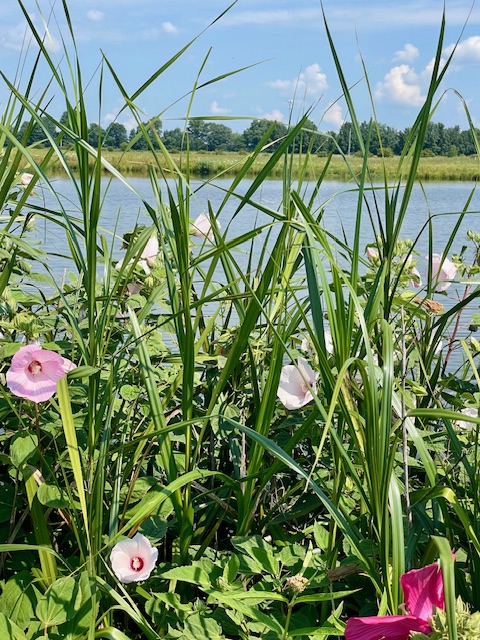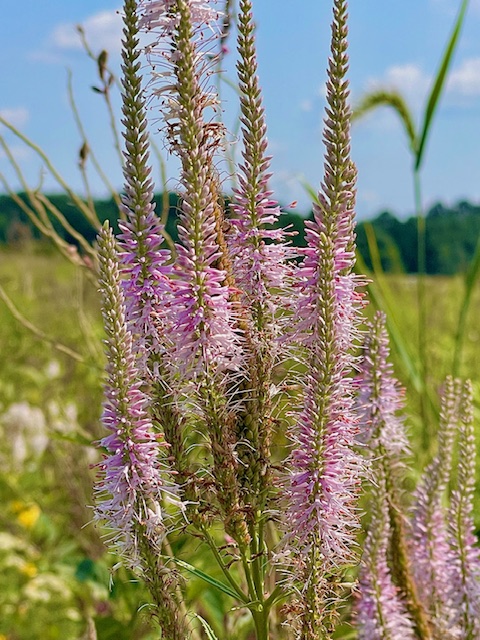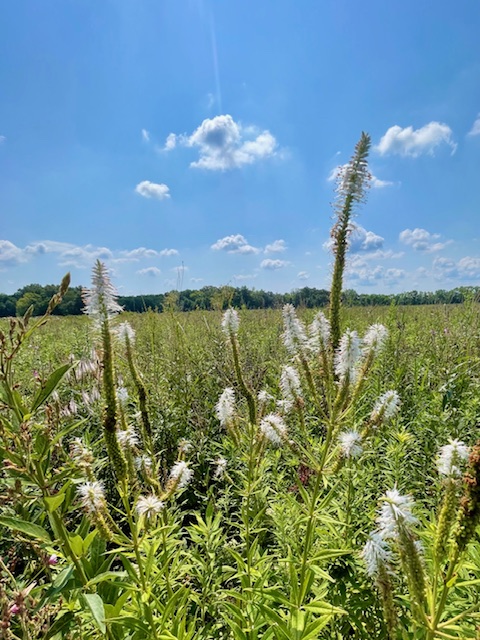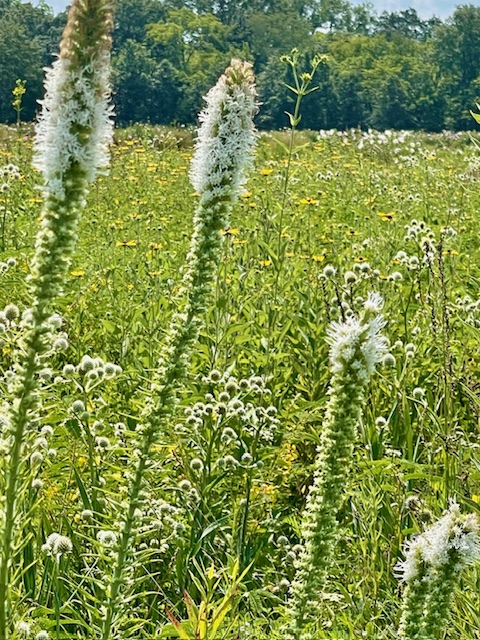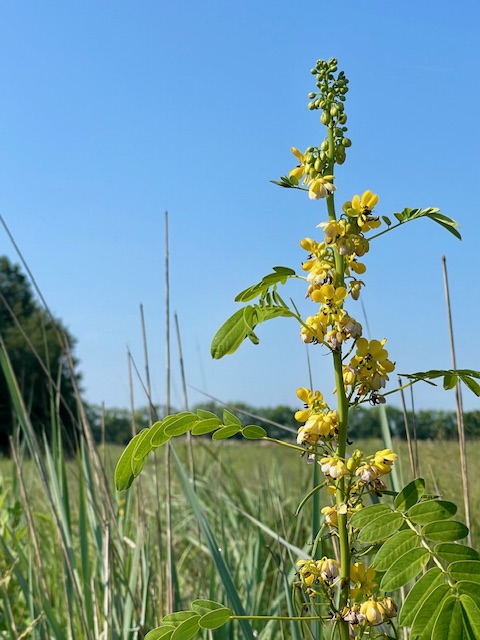Plant Profile: A Handful of Hibiscus Seed

By Henry Eilers
On August 19 at 9 am we met at Glenn and Nancy Savage’s place on Quail Lane to view their amazing and extensive prairie and wetland restorations. Emilee Hale, Pheasants Forever biologist led a group of participants from PF, local soil and water conservation districts and several federal agencies. Also participating were 5 members of the Illinois Native Plant Society.
Route 66 Prairie was also on the agenda but after 3½ hours of exploring this extraordinary site, that had to be cancelled.
To quote Emilee for some background information: “PF is focused on putting habitat on the ground for quail, pheasants and other wildlife. A great way to do this is to educate the community about the federal Conservation Reserve Program [CRP for short] and habitat conservation by giving them a hands-on experience to see what good habitat looks like and how to manage it. PF is able to do this by working with local landowners to host habitat tours. These are some of the best ways to learn plant identification and management techniques in person with someone who has been managing habitat for many years. The guests were able to see what nearly 30 years of management looks like on a CRP practice and what tools are being used to accomplish it. They were also able to see how different CRP practices are being used to combat soil erosion and habitat loss”.
Glenn’s 60-acre CRP site is a mature example of that. Most such sites elsewhere are low diversity to begin with and go down-hill from there. Glenn has consistently invested in weed control and burn management over the decades. Above all and for a long time, he purchased additional high diversity seed mixes at the end of the selling season from Ken Schaal’s Bluestem Prairie Nursery.
We were treated to grand displays of Blazing-star, all sorts of yellow composites [sunflowers], beebalm, mountain mints and much more. Compass-plant and Prairie Dock, true prairie sentinels, were especially remarkable. They reach to 10’ at Route 66 Prairie this summer. I made a lot of comparisons between these 2 sites. Both are in the very northwest section of the Southern Illinois Tillplain. Like siblings in a family these sites have much in common but also show marked differences. It’s fun to tease out the reasons for the differences. Some might rather say ‘it’s just speculation’ and they might be correct as well.
Did I mention wetland restorations? Yes, some 5-10 acres. We visited them last, and it was frosting on the cake, so to speak.
The berm of a large shallow pond on its west and south sides was lined with a dense stand of Hibiscus in glorious bloom; flowers in a range of color, by the thousands and thousands. Additional clumps were scattered widely elsewhere over a large area of marshy ground to the north and west from the pond. Saying that it was spectacular hardly does it justice. Most of it all was Hibiscus lasiocarpos. I used to call it H. moscheotos. Not sure if the nomenclature has been settled. There was also some Halberd-leaved Hibiscus. That used to be H. militaris but is H. laevis now.
Glenn told the crowd that all this started with a handful of Hibiscus seed that I had given him, many years ago.










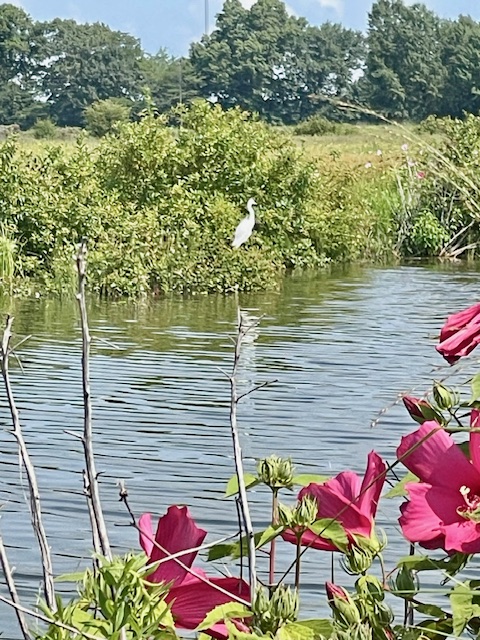
The nomenclature is ‘worse’ on another plant here. I will stick with Scirpus fluviatilis, but that is just one of three botanical names. This is Bulrush and forms remarkably dense thickets to over 6’ tall. I have never seen it flower. We have it at Route 66 Prairie and you can get lost just wading in a few feet. But here it is sparse. And so are Cattails [Typha latifolia]. I believe Glenn told me that he manipulates the water level of his pond to keep them in bounds. That, too, is interesting. So much to learn.
Much of the pond edge was dominated by a dense band of Soft Rush plants [Juncus effusus]. I like it as I have a long relationship with this plant. Back in Germany, now over 70 years ago it was common in our wet pasture lands. And I have seen it in Costa Rica! Supposedly it occurs on all continents. My plants and consequently these came from a single site in Macoupin County. Let’s face it, we started wiping out our wetland and wet prairie sites some 200 years ago!
I explored a bit on the west side and unexpectedly found a huge spike rush [Eleocharis spp.] meadow. Mimulus was in bloom, partially in shallow water here. Further out were notable stands of Wool grass [Scirpus cyperinus]. Glenn has it abundantly in other damp areas. I have only found it twice over the decades in our area, and all these sites are gone. Equally uncommon was a scattering of Stout Rush [Juncus nodatus] that I found in the spike rush meadow. That rush along with a plethora of sedges and other wetland plants could be found occasionally in our railroad ditches from here to Mt. Olive. We have tried to salvage these local ecotypes at Route 66 Prairie but without success so far. Both species have done exceedingly well at the Hillsboro Bremer Sanctuary dry dam ponds. Why the differences? It keeps us humble.


